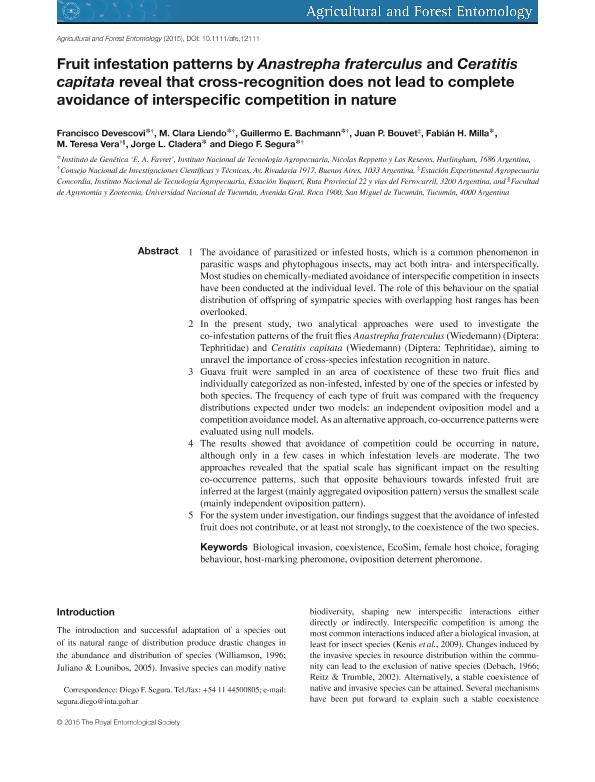Artículo
Fruit infestation patterns by Anastrepha fraterculus and Ceratitis capitata reveal that cross-recognition does not lead to complete avoidance of interspecific competition in nature
Devescovi, Francisco ; Liendo, María Clara
; Liendo, María Clara ; Bachmann, Guillermo Enrique
; Bachmann, Guillermo Enrique ; Bouvet, Juan Pedro Raúl; Milla, Fabian Horacio; Vera, Maria Teresa
; Bouvet, Juan Pedro Raúl; Milla, Fabian Horacio; Vera, Maria Teresa ; Cladera, Jorge Luis; Segura, Diego Fernando
; Cladera, Jorge Luis; Segura, Diego Fernando
 ; Liendo, María Clara
; Liendo, María Clara ; Bachmann, Guillermo Enrique
; Bachmann, Guillermo Enrique ; Bouvet, Juan Pedro Raúl; Milla, Fabian Horacio; Vera, Maria Teresa
; Bouvet, Juan Pedro Raúl; Milla, Fabian Horacio; Vera, Maria Teresa ; Cladera, Jorge Luis; Segura, Diego Fernando
; Cladera, Jorge Luis; Segura, Diego Fernando
Fecha de publicación:
08/2015
Editorial:
Wiley Blackwell Publishing, Inc
Revista:
Agricultural And Forest Entomology
ISSN:
1461-9555
Idioma:
Inglés
Tipo de recurso:
Artículo publicado
Clasificación temática:
Resumen
1- The avoidance of parasitized or infested hosts, which is a common phenomenon in parasitic wasps and phytophagous insects, may act both intra- and interspecifically. Most studies on chemically-mediated avoidance of interspecific competition in insects have been conducted at the individual level. The role of this behaviour on the spatial distribution of offspring of sympatric species with overlapping host ranges has been overlooked.
2- In the present study, two analytical approaches were used to investigate the co-infestation patterns of the fruit flies Anastrepha fraterculus (Wiedemann) (Diptera: Tephritidae) and Ceratitis capitata (Wiedemann) (Diptera: Tephritidae), aiming to unravel the importance of cross-species infestation recognition in nature.
3- Guava fruit were sampled in an area of coexistence of these two fruit flies and individually categorized as non-infested, infested by one of the species or infested by both species. The frequency of each type of fruit was compared with the frequency distributions expected under two models: an independent oviposition model and a competition avoidance model. As an alternative approach, co-occurrence patterns were evaluated using null models.
4- The results showed that avoidance of competition could be occurring in nature, although only in a few cases in which infestation levels are moderate. The two approaches revealed that the spatial scale has significant impact on the resulting co-occurrence patterns, such that opposite behaviours towards infested fruit are inferred at the largest (mainly aggregated oviposition pattern) versus the smallest scale (mainly independent oviposition pattern).
5- For the system under investigation, our findings suggest that the avoidance of infested fruit does not contribute, or at least not strongly, to the coexistence of the two species.
Archivos asociados
Licencia
Identificadores
Colecciones
Articulos(CCT - NOA SUR)
Articulos de CTRO.CIENTIFICO TECNOL.CONICET - NOA SUR
Articulos de CTRO.CIENTIFICO TECNOL.CONICET - NOA SUR
Citación
Devescovi, Francisco; Liendo, María Clara; Bachmann, Guillermo Enrique; Bouvet, Juan Pedro Raúl; Milla, Fabian Horacio; et al.; Fruit infestation patterns by Anastrepha fraterculus and Ceratitis capitata reveal that cross-recognition does not lead to complete avoidance of interspecific competition in nature; Wiley Blackwell Publishing, Inc; Agricultural And Forest Entomology; 17; 3; 8-2015; 325-335
Compartir
Altmétricas



